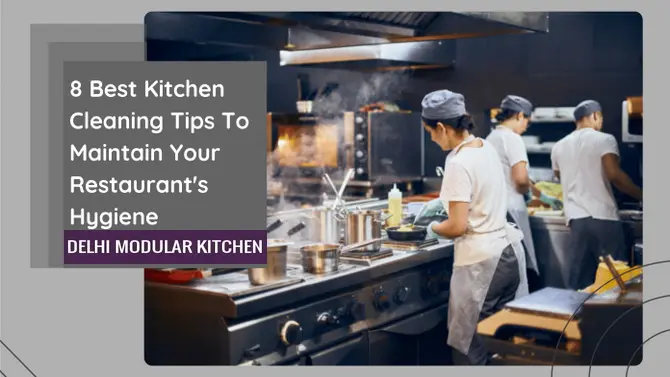
8 Tips How to Keep Your Commercial Kitchen Immaculate
How to Keep Your Commercial Kitchen Spotless
A spotless commercial kitchen is more than just a reflection of your restaurant’s professionalism. It’s the backbone of food safety and customer satisfaction. For restaurant owners, kitchen managers, and food service professionals. Maintaining cleanliness is crucial to running a successful culinary operation.
In this comprehensive guide, we’ll explore the essential steps and strategies. To keep your commercial kitchen immaculate. Hence, ensuring a safe and welcoming environment for both staff and customers.
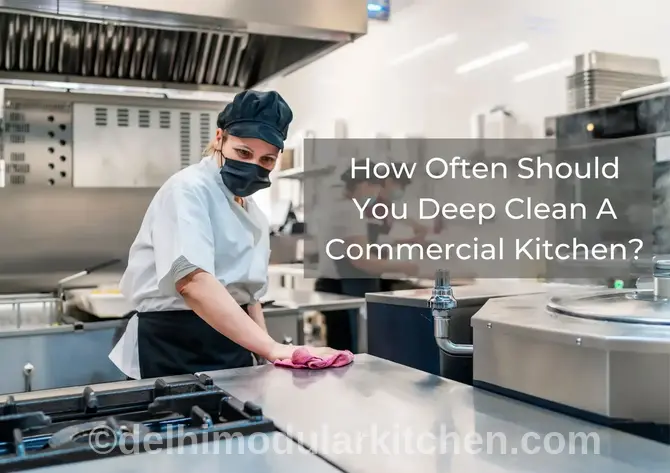
The Cost of Poor Hygiene
Failing to maintain high hygiene standards in a commercial kitchen. Can have dire consequences. Financially, it may lead to costly fines from health inspections. Or even temporary closures, which can severely dent profits.
A tarnished reputation is equally damaging. As word of poor cleanliness spreads quickly. Furthermore, deterring potential customers and eroding trust with loyal patrons. Ultimately, ignoring hygiene can result in severe health risks, including food-borne illnesses. That pose a threat to both employees and diners.
Beyond financial and reputational repercussions, poor hygiene can also affect staff morale. Employee stake pride in working in a clean environment. And neglecting cleanliness may lead to dis-satisfaction and high turnover rates. Additionally, an unkempt kitchen can lead to inefficiencies and accidents. Further impacting operational costs.
The importance of maintaining hygiene cannot be over-stated. For business owners and managers. Investing in cleanliness, not only protects the bottom line. But also ensures a safe and healthy workplace, fostering customer confidence and loyalty.
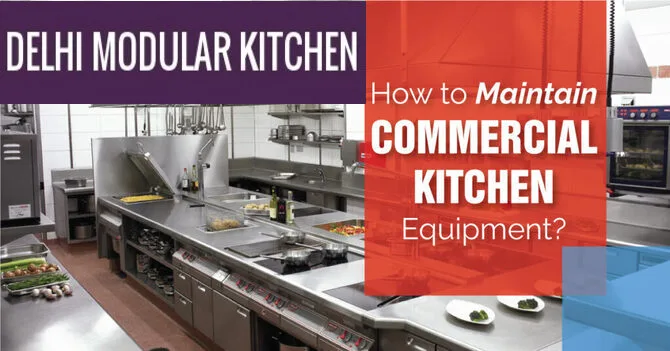
Daily Cleaning Checklist
Implementing a daily cleaning routine is the first step. Toward maintaining cleanliness in your commercial kitchen. Start by wiping down all surfaces with a suitable disinfectant. This includes prep-tables, countertops, and cutting boards. Which can harbour bacteria if left uncleaned. Regularly, sanitizing these surfaces reduces cross-contamination and ensures food safety.
Next, focus on cleaning kitchen equipment. Ovens, grills, and fryers accumulate grease and residues. That, if left unaddressed, can become fire hazards. Use de-greasers and specialized cleaning tools to keep these appliances in top condition. Additionally, remember to empty and clean refrigerator drip trays. To prevent mould and mildew growth.
Lastly, make sure to clean the floors thoroughly. Sweep up any debris, then mop the entire area with a strong, non-slip cleaner. Pay extra attention to corners and under appliances where dirt can accumulate. A clean floor not only reduces slip hazards. But also creates a pleasant working environment for your staff.
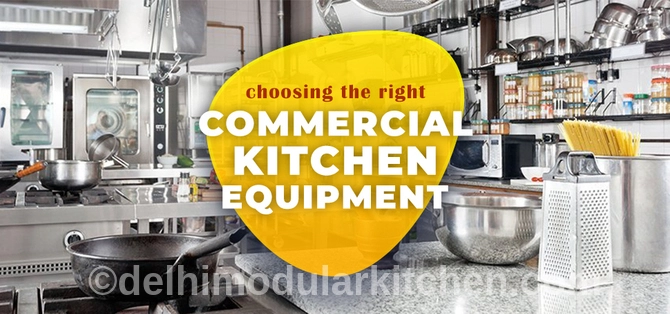
Weekly Deep Cleaning
Deep cleaning tasks should be performed weekly. To maintain a high standard of hygiene. Begin with exhaust hoods and vents. Grease build-up in these areas can hinder airflow and present a fire risk. So it’s essential to thoroughly clean and de-grease them.
Focus on sanitizing walk-in refrigerators and freezers. Remove all items, clean shelves and walls with a food-safe disinfectant. And allow them to dry before restocking. This prevents bacterial growth and keeps food fresh longer.
Finally, tackle the kitchen’s smaller equipment. Such as blenders, mixers, and food processors. Disassemble these appliances, wash each component with hot and soapy water. Ensure they’re completely dry before re-assembly. This routine helps maintain equipment efficiency and extend its lifespan.

Monthly and Quarterly Maintenance
Certain areas of your kitchen require less frequent but equally important maintenance. Monthly, focus on plumbing and drainage systems. Inspect sinks and drains for clogs or leaks. Moreover, addressing any issues promptly to avoid costly repairs and water damage.
Quarterly, assess your pest control measures. Engage a professional service to inspect the premises and apply preventive treatments. Keeping pests at bay is critical. For maintaining hygiene and complying with health regulations.
Additionally, schedule regular maintenance for major equipment. such as stoves, dishwashers, and refrigeration units. Professional servicing ensures optimal performance, reduces energy consumption,and minimizes unexpected breakdowns.
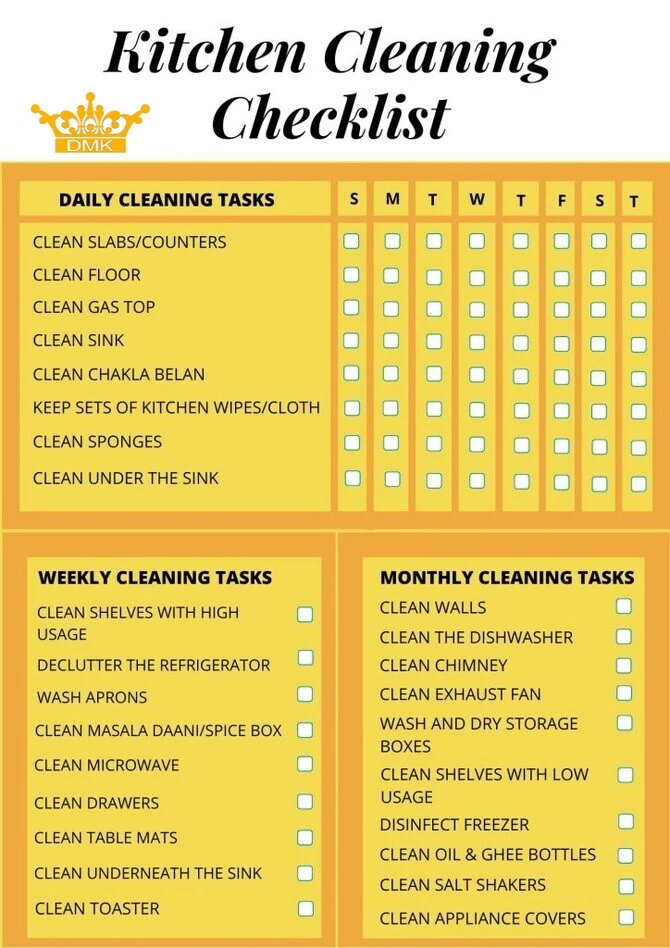
Importance of Staff Training
Well-trained staff are essential for maintaining a clean kitchen. Begin by educating them on the importance of cleanliness and hygiene. Further, highlighting the direct impact on food safety and customer satisfaction. Regular training sessions reinforce these principles. And keep best practices top of mind.
Teach employees how to properly use cleaning products and equipment. Demonstrating the correct techniques for scrubbing and sanitizing. Next, handling chemicals ensures effective cleaning and reduces the risk of accidents. Encourage staff to take ownership of their workstations. And fostering a sense of pride and responsibility.
Finally, implement a buddy system, pairing new hires with experienced staff members. This mentorship approach helps to instill a culture of cleanliness. And ensures consistent adherence to hygiene standards.
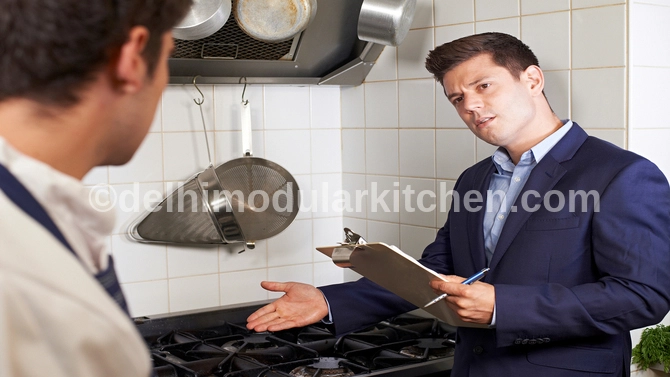
Choosing the Right Cleaning Products
Selecting the right cleaning products is crucial for effective kitchen hygiene. Opt for non-toxic, food-safe cleaners that are specifically designed for commercial kitchens. These products provide powerful sanitation. Without introducing harmful chemicals into the food preparation area.
When choosing detergents and disinfectants, consider their effectiveness against bacteria and viruses. Look for products with proven results and certifications from reputable health organizations. Additionally, select products that are easy to use. And require minimal rinsing, saving time and reducing water consumption.
Stock a variety of cleaning tools, including scrub brushes, squeegees, and microfiber cloths. These versatile tools make it easier to clean different surfaces. And reach tight spaces, ensuring thorough sanitation.
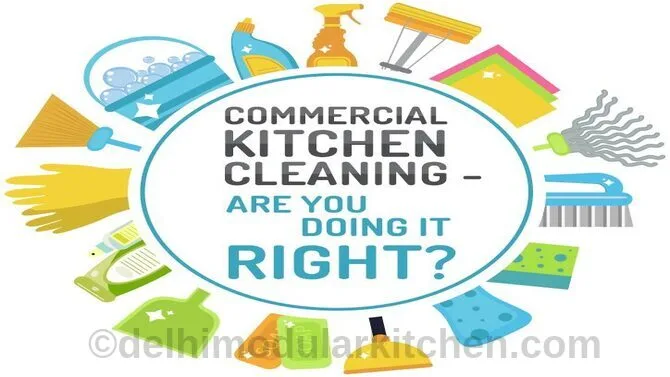
Implementing a Cleaning Schedule
Creating a cleaning schedule is fundamental to maintaining a spotless kitchen. Start by outlining daily, weekly, and monthly tasks. Clearly assigning responsibilities to specific staff members. This structure ensures all tasks are completed consistently and no areas are overlooked.
Use visual aids, such as checklists and calendars. To keep the schedule accessible and easy to follow. Display these tools prominently in the kitchen. To remind staff of their duties and promote accountability.
Regularly review and adjust the schedule as needed. Accommodating changes in staffing, equipment, or kitchen layout. Flexibility ensures the schedule remains effective and relevant, supporting ongoing cleanliness efforts.
The Role of Technology in Kitchen Hygiene
Technology offers innovative solutions for maintaining kitchen cleanliness. Automated cleaning systems. Such as dish washing machines and robotic floor scrubbers. Streamline tasks and reduce labour costs. These systems improve consistency and efficiency, allowing staff to focus on more complex duties.
Digital management tools, such as scheduling apps and inventory trackers. Enhance organization and accountability. By digitizing cleaning checklists and maintenance logs. Managers can easily monitor progress and identify areas for improvement.
Invest in temperature monitoring devices for refrigeration units. These tools provide real-time data and alerts. Ensuring food is stored safely and reducing the risk of spoilage.

Benefits of a Spotless Commercial Kitchen
- Enhances food safety and hygiene compliance.
- Reduces the risk of pest infestations.
- Increases the lifespan of equipment and appliances.
- Boosts employee morale and productivity.
- Impresses health inspectors and customers.
Daily Cleaning Routine for a Spotless Commercial Kitchen
- Clean all surfaces: Wipe down countertops, tables, and prep areas with a food-safe cleaner.
- Wash utensils and tools: Clean and sanitize knives, cutting boards, and other kitchen tools.
- Sweep and mop floors: Remove dirt, grease, and food debris to prevent slips and pests.
- Empty trash bins: Dispose of waste promptly and replace liners to avoid odors.
- Sanitize high-touch areas: Focus on doorknobs, handles, and switches to reduce germ spread.
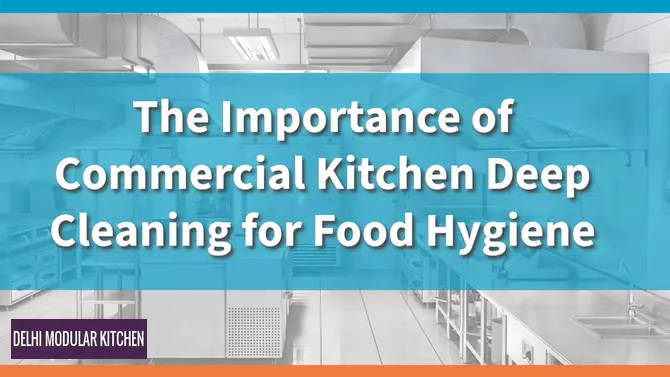
Top Cleaning Supplies for Commercial Kitchens
- Degreasers for stubborn grease and oil.
- Heavy-duty sponges and scouring pads.
- Microfiber cloths for streak-free surfaces.
- Mops and buckets for deep floor cleaning.
- Food-safe sanitizers and disinfectants.
Steps for Deep Cleaning a Commercial Kitchen
- Clear the workspace: Remove all tools, utensils, and equipment from surfaces.
- Degrease appliances: Scrub ovens, stoves, and grills with a heavy-duty degreaser.
- Scrub hard-to-reach areas: Clean behind appliances and under counters.
- Disinfect surfaces: Use food-safe disinfectants on prep areas and cutting boards.
- Polish floors and walls: Use appropriate cleaning solutions for a spotless finish.
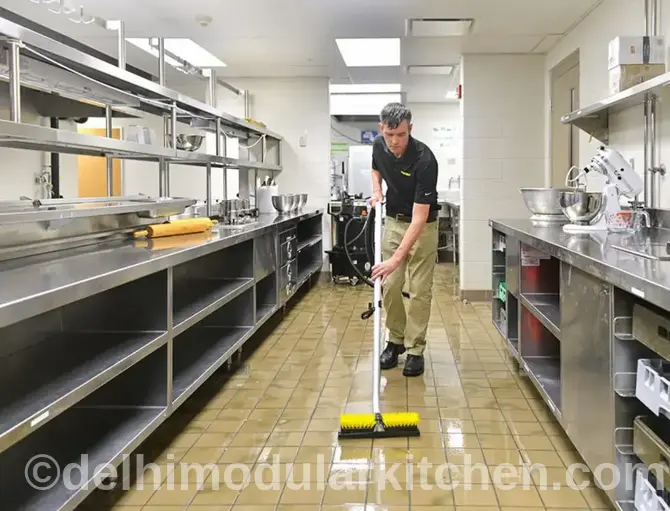
Conclusion
Maintaining a clean commercial kitchen is vital for food safety. Customer satisfaction, and business success. By implementing the strategies outlined in this guide. A restaurant owners, kitchen managers, and food service professionals. Can ensure a hygienic environment that supports culinary excellence.
Consistent cleaning routines, staff training, and the right products and technology. Are essential for achieving and sustaining high hygiene standards. For those eager to explore further, consulting industry experts and attending workshops. Can provide additional insights and best practices.
Ultimately, cleanliness is an investment in your business’s future. By prioritizing hygiene, you protect your reputation, minimize risks. And create a positive dining experience that keeps customers coming back.
| How to Keep a Commercial Kitchen Clean | “10 Expert Tips to Keep Your Commercial Kitchen Clean and Hygienic” | “Learn 10 expert tips to maintain a spotless, hygienic commercial kitchen efficiently and professionally.” | “Image of a sparkling clean commercial kitchen with professional-grade appliances.” | Seeking actionable tips for cleanliness. |
| Commercial Kitchen Cleaning Checklist | “The Ultimate Commercial Kitchen Cleaning Checklist for Spotless Results” | “Download our step-by-step commercial kitchen cleaning checklist for easy maintenance and hygiene.” | “Checklist for cleaning commercial kitchen areas like floors, ovens, and countertops.” | Looking for a downloadable resource. |
| Daily Cleaning for Commercial Kitchens | “Daily Cleaning Routine for Spotless Commercial Kitchens: Step-by-Step Guide” | “Master a daily cleaning routine to keep your commercial kitchen pristine and safe for food preparation.” | “Cleaner wiping down a stainless steel countertop in a commercial kitchen.” | Seeking daily cleaning routines. |
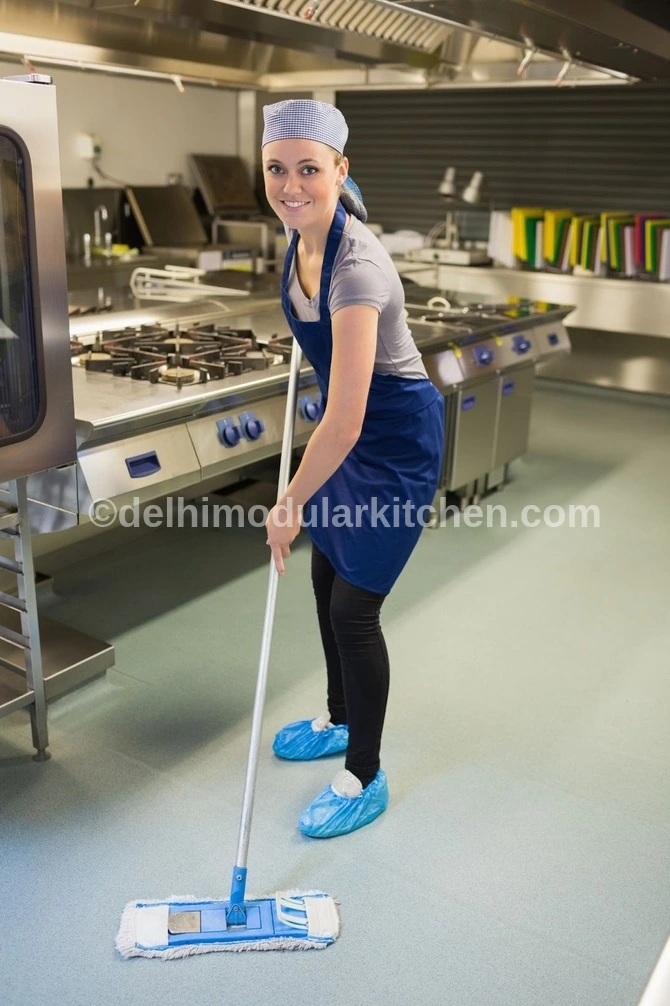
| Importance of Kitchen Hygiene | “Why Kitchen Hygiene Matters: A Guide for Commercial Spaces” | “Discover why maintaining kitchen hygiene is crucial for food safety and customer trust in your business.” | “A close-up of sanitized kitchen tools neatly organized.” | Learning the importance of hygiene. |
| Commercial Kitchen Cleaning Supplies | “Top 10 Cleaning Supplies for a Spotless Commercial Kitchen” | “Find the best cleaning supplies to make your commercial kitchen shine effortlessly.” | “Various cleaning supplies like degreasers, mops, and brushes for kitchens.” | Searching for cleaning products. |
| Deep Cleaning Commercial Kitchen | “How to Perform a Deep Clean in Your Commercial Kitchen: A Step-by-Step Guide” | “Step-by-step guide for deep cleaning your commercial kitchen, ensuring spotless surfaces and food safety.” | “Before and after photos of a deep-cleaned commercial kitchen.” | Wanting deep-cleaning methods. |
| Commercial Kitchen Cleaning Services | “Hire the Best Commercial Kitchen Cleaning Services Near You” | “Discover professional commercial kitchen cleaning services to ensure spotless and hygienic environments.” | “A team of professionals cleaning a commercial kitchen with industrial tools.” | Searching for cleaning services. |
| Kitchen Cleaning Tips for Restaurants | “10 Quick and Easy Kitchen Cleaning Tips for Restaurants” | “Explore 10 simple and effective tips to keep your restaurant kitchen sparkling clean every day.” | “A chef cleaning a stove in a busy restaurant kitchen.” | Looking for restaurant-specific tips. |
| Food Safety in Commercial Kitchens | “The Role of Cleanliness in Food Safety for Commercial Kitchens” | “Learn how maintaining a spotless kitchen directly impacts food safety and regulatory compliance.” | “Illustration of a food safety checklist and cleaning supplies.” | Understanding food safety connections. |
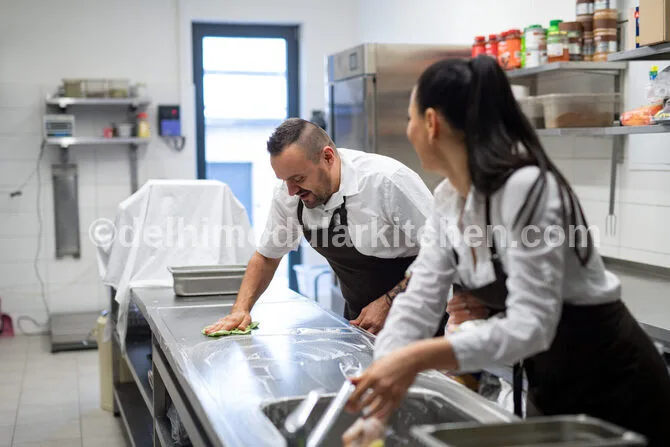
FAQ
What are the most common cleaning tasks in a commercial kitchen?
Daily tasks include sanitizing surfaces, cleaning equipment, and mopping floors. Weekly deep-cleaning tasks involve de-greasing exhaust hoods, sanitizing refrigerators, and cleaning smaller appliances.
How can I ensure my staff follows the cleaning schedule?
Assign specific tasks to individual staff members. And use visual aids like checklists and calendars. Regularly review and adjust the schedule to accommodate changes and ensure consistency.
What type of cleaning products should I use in my commercial kitchen?
Opt for non-toxic, food-safe cleaners designed for commercial kitchens. Choose products with proven effectiveness against bacteria and viruses. And stock a variety of cleaning tools for different surfaces.

